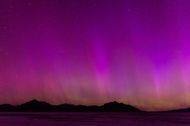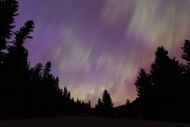The Northern Lights, or the Aurora Borealis, are expected to be seen across some regions of the United States on Thanksgiving Day (November 28) and Black Friday (November 29). The National Oceanic and Atmospheric Administration (NOAA) has forecasted a G1 (minor) storm watch for Thursday and a G2 (moderate) storm watch for Friday, meaning there are likely to be good aurora sightings in northern states.
Where to watch
The most favorable locations for viewing the Northern Lights during this period include:
- Maine
- Northern Michigan
- Areas of the Upper Midwest, such as Minnesota, Wisconsin, and other northern states.
Should the sightings occur under especially intense geomagnetic conditions, they might enter even further south, into areas like New York and Idaho. Nevertheless, some of the areas might be obscured by local weather conditions such as cloudiness due to an incoming winter storm.
When to watch
Auroras are generally observed from shortly after sunset to shortly before sunrise. While you’ll be able to observe auroras during other times of the night as well depending on the location, staying out during these hours helps to maximize your chances to catch this natural phenomenon.
Resources such as NOAA’s Aurora Dashboard offer real-time updates and they reveal visibility conditions of the aurora.
Optimal conditions for viewing

To maximize the chances of witnessing the Northern Lights:
Timing: It is generally recommended that one look for auroras between 9 PM and 2 AM; with the peak starting around 11 PM till midnight.
Location: Look for places where there is low light intensity from the artificial light, preferably farmhouses that are built facing north.
Weather: There cannot be any form of cloud since this will even hinder visibility totally. Local weather reports on the days leading up to the viewing nights will also prove to be important.
Key background

Currently, we are at the peak through solar cycle 25, an approximately 11-year cycle of magnetic activity from the Sun. This solar cycle began in December 2019 and now is in Solar Maximum.
The Solar Maximum is a crucial stage in the solar cycle wherein the solar activity is high and includes many sun spots, flares, and Coronal Mass Ejections (CMEs). Solar maximum is predicted to happen between late 2024 and early 2026 by both NASA and NOAA, with the highest sunspots expected between July 2025.
Due to the increased emission of charged particles from the sun, one experiences more pronounced auroral displays (the northern and southern lights). These particles encounter the magnetosphere of the earth and produce light displays best seen at higher latitudes. Scientists believe that this coming Solar Maximum will be followed by some of the most spectacular light shows in over ten years.
What is the Aurora Borealis?

Aurora Borealis also referred to as the Northern Lights, is a beautiful phenomenon that manifests itself when particles from the Sun hit gaseous pockets in the Earth’s atmosphere. These interactions result in bioluminescent lighting, most predominantly green, but also in pink, red, yellow, blue, and violet hues.
